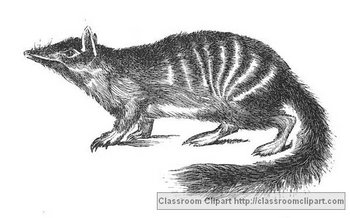Anteater
|
|
It is extensively distributed in the tropical parts of South and Central America, frequenting low swampy savannas, along the banks of rivers, and the depths of the humid forests, but is nowhere abundant.
Its food consists mainly of termites, which it obtains by opening their nests with its powerful sharp anterior (front) claws. As the insects swarm to the damaged part of their dwelling, it draws them into its mouth by means of its long, flexible, rapidly moving tongue covered with sticky saliva. Anteaters are specialized to feed on ants, termites and sometimes spiders, each anteater species having its own insect preferences: small species are specialized on arboreal insects living on small branches, while large species can penetrate the hard covering of the nests of terrestrial insects. To avoid the jaws, sting, and other defences of the invertebrates, anteaters have adopted the feeding strategy to lick up as many ants and termites as quickly as possible — an anteater normally spends about a minute at a nest before moving on to another — and a giant anteater has to visit up to 200 nests to consume the thousands of insects it needs to satisfy its caloric requirements. [6]
The anteater's tongue is covered with thousands of tiny hooks called filiform papillae which are used to hold the insects together with large amounts of saliva. Swallowing and the movement of the tongue are aided by side-to-side movements of the jaws. The anteater's stomach, similarly to a bird's gizzard, has hardened folds and uses strong contractions to grind the insects; a digestive process assisted by small amounts of ingested sand and dirt. [6] The tongue is attached to the sternum and moves very quickly, flicking 150 times per minute.
Anteater habitats includes dry tropical forests, rainforests, grasslands, and savannas. The silky anteater (Cyclopes didactylus) is specialized to an arboreal environment, but the more opportunistic tamanduas find their food both on the ground and in trees, typically in dry forests near streams and lakes. The almost entirely terrestrial giant anteater (Myrmecophaga tridactyla) lives in savannas. [6] The two anteaters of the genus Tamandua, the southern (Tamandua tetradactyla) and the northern tamanduas (Tamandua mexicana), are much smaller than the giant anteater, and differ essentially from it in their habits, being mainly arboreal. They inhabit the dense primeval forests of South and Central America. The usual colour is yellowish-white, with a broad black lateral band, covering nearly the whole of the side of the body.
The silky anteater (Cyclopes didactylus) is a native of the hottest parts of South and Central America, and about the size of a cat, of a general yellowish color, and exclusively arboreal in its habits.
The Giant Anteater lives above ground, not burrowing underground like armadillos. Though generally an inoffensive animal, when attacked it can defend itself with its sharp claws. The female produces one offspring per birth.
The two tamandua anteaters, as typified by Tamandua (or Uroleptes) tetradactyla, are much smaller than the Giant Anteater, and differ essentially from it in their habits, being mainly tree-dwelling. They inhabit the dense primeval forests of South and Central America. The usual colour is yellowish-white, with a broad black lateral band, covering nearly the whole of the side of the body.
The Silky Anteater (Cyclopes didactylus) is a native of the hottest parts of South and Central America, and about the size of a rat, of a general yellowish color, and exclusively tree-dwelling.
Anteaters are mammals of the order Xenarthra and the family Myrmecophagidae.- ORDER XENARTHRA
- Family Myrmecophagidae
- Silky Anteater, Cyclopes didactylus
- Giant Anteater, Myrmecophaga tridactyla
- Northern Tamandua, Tamandua mexicana
- Southern Tamandua, Tamandua tetradactyla
- Family Megalonychidae: two toed sloths
- Family Bradypodidae: three toed sloths
- Family Dasypodidae: armadillos
- Family Myrmecophagidae
Similar animals
- Pangolins are also called scaly anteaters.
- The Numbat (Myrmecobius fasciatus), a marsupial, formerly called the Banded Anteater.
- Echidnas, a family of monotremes, are still sometimes called spiny anteaters.
- Aardvarks are African animals with similar habits.
- Leaf-cutting ants are among anteater's favorite diet.
| Anteater Facts | ||||||||||
|---|---|---|---|---|---|---|---|---|---|---|
 Giant Anteater | ||||||||||
| Scientific classification | ||||||||||
| ||||||||||
| Genera | ||||||||||
Clipart and Animal Pictures
- Clipart (https://classroomclipart.com/image/category/clipart.htm)
- Animal Clipart (https://classroomclipart.com/image/category/animal-clipart.htm)
- Animal Animated Clipart (https://classroomclipart.com/clipart/Animations/Animals.htm)
- Pictures of Animals (https://classroomclipart.com/image/category/animal-photos.htm)
- Amphibian Clip Art, Pictures and Photogaphs (https://classroomclipart.com/image/category/amphibian-clipart.htm)
- Farm Animal Clip Art, Pictures and Photographs (https://classroomclipart.com/image/category/farm-animal-clipart.htm)
- Mammal Clip Art, Pictures and Photographs (https://classroomclipart.com/image/category/mammal-clipart.htm)
- Marine Animal Clip Art, Pictures and Photographs (https://classroomclipart.com/image/category/marine-life-clipart.htm)
- Reptile Clip Art, Pictures and Photographs (https://classroomclipart.com/image/category/reptile-clipart.htm)
- Spider Clip Art, Pictures and Photographs (https://classroomclipart.com/image/category/spider-clipart.htm)






